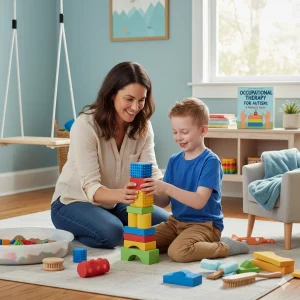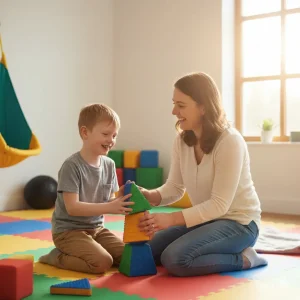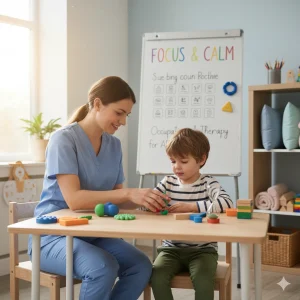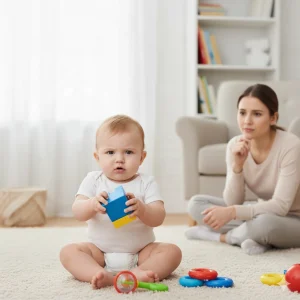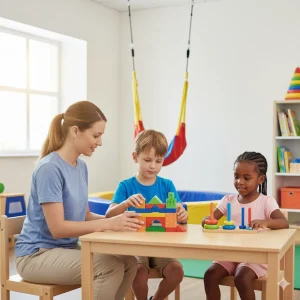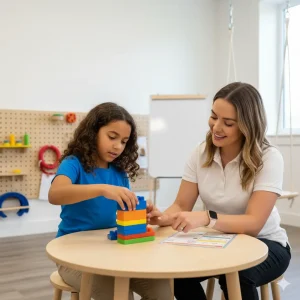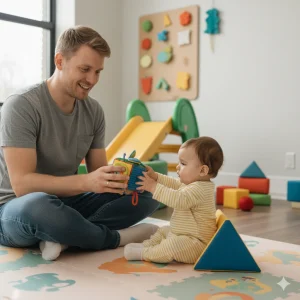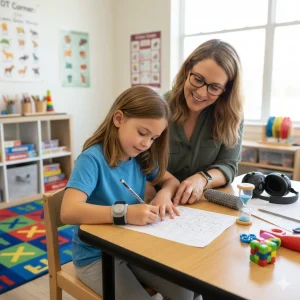How Occupational Therapy Helps Kids Build Life Skills
By Wellness Hub
Last Updated: October 25, 2025
When your child struggles to button a shirt, hold a crayon, or sit still at the table, it can leave you wondering: “Is this just a phase—or does my child need extra help?”
That’s exactly where occupational therapy for kids makes a difference.
Occupational therapy turns everyday struggles into stepping-stones for independence. Through play, movement, and practical routines, a pediatric occupational therapist helps children between 2 and 6 years strengthen fine-motor skills, sensory awareness, and self-confidence.
In this guide, you’ll learn how OT supports daily life—from getting dressed to focusing in class—why early intervention matters, and how small changes at home can spark lifelong skills. Because every milestone your child reaches isn’t just progress—it’s freedom.
When Everyday Tasks Feel Hard — Common Struggles in Ages 2–6
For many parents, watching their child struggle with simple daily tasks can be both confusing and worrying. Between the ages of 2 to 6, children are learning vital daily living skills — from using utensils and dressing up to managing emotions and paying attention. When these milestones don’t come easily, it doesn’t mean your child isn’t trying; it simply means they may need a little extra support.
Here are some common struggles parents notice during early childhood:
- Dressing challenges: Trouble with buttons, zippers, or putting clothes on in the right order may signal developing fine motor skills that need more practice.
- Feeding difficulties: Some kids struggle to hold a spoon, chew certain textures, or tolerate messy foods — often linked to sensory sensitivities or coordination issues.
- Attention and focus: Short attention spans or frequent wandering during playtime can make structured tasks, like puzzles or storytime, difficult to complete.
- Emotional regulation: Meltdowns over small frustrations, changes in routine, or loud sounds may reflect challenges in sensory processing or self-regulation.
- Handwriting and pre-writing readiness: If your child avoids coloring, struggles to hold a crayon, or tires quickly, it may point to weaker hand and finger control that affects early writing skills.
According to the CDC’s developmental milestones, children between ages two and six typically gain better hand control, emotional balance, and independence in self-care. If these skills appear delayed or inconsistent, occupational therapy can help bridge the gap through playful, developmentally tailored activities.
Remember: every child develops at their own pace — but early support helps turn frustration into confidence.
How Occupational Therapy Helps — Core Skill Areas
Occupational therapy works like a bridge — connecting where your child is today to the skills they need for independence tomorrow. For children between 2 and 6 years, this support focuses on building strong foundations across different developmental areas. Through play, exploration, and guided activities, therapists help children strengthen fine motor skills, gross motor coordination, sensory processing, and social participation — all while keeping sessions fun and engaging.
Here’s how each skill area supports your child’s growth:
| Skill Area | What It Involves | Therapy Goals & Real-Life Benefits |
|---|---|---|
| Fine Motor Skills | Small muscle movements — using hands, fingers, and wrists for tasks like buttoning, drawing, or picking up small objects. | Build finger strength, improve pencil control, and promote independence in dressing, feeding, and school readiness. |
| Gross Motor Skills | Big body movements — balance, jumping, climbing, or catching a ball. | Strengthen coordination, posture, and endurance to support confident movement during play and daily routines. |
| Sensory Integration | How the brain processes touch, sound, movement, and visual input. | Help children manage sensory sensitivities, regulate emotions, and stay calm and focused during daily activities. |
| Hand–Eye Coordination | Linking what a child sees with how they move their hands. | Improve accuracy in stacking blocks, writing, and catching — crucial for classroom tasks and playtime. |
| Social and Play Skills | Learning to share, take turns, and communicate during play. | Build confidence, empathy, and positive peer interactions — essential for early school success. |
Small steps in therapy often lead to big milestones in life — one button, one drawing, one smile at a time.
Fine-Motor Skills: From Tiny Hands to Big Achievements
If you’ve ever watched your child struggle to hold a crayon, stack blocks, or button a shirt, you’ve seen how much effort those little hands put into learning. These are called fine motor skills — the small but powerful movements that help children grasp, pinch, cut, and write. Strengthening these skills is key to writing readiness, self-care, and overall independence.
Occupational therapy uses play-based, hands-on methods to make fine-motor learning fun. But as a parent, you can also nurture these skills at home with simple, everyday activities. Here’s how:
1. Play with Play-Dough
Rolling, squishing, and pinching dough builds grasp strength and finger dexterity. Hide tiny beads inside and let your child find them — a playful way to exercise small muscles.
2. Try Tongs and Tweezers Games
Use kitchen tongs or tweezers to pick up pom-poms, beads, or cereal pieces. This strengthens the same muscles used for pencil control and improves focus and coordination.
3. Practice Pencil Grips and Tracing
Let your child experiment with child-friendly pencil grips or thick crayons that are easier to hold. Tracing shapes, coloring within lines, or connecting dots helps with pre-writing control.
4. Introduce Safe Scissor Practice
Cutting along bold lines or through soft materials like play-dough snakes improves hand-eye coordination and bilateral hand use — skills essential for school tasks.
5. Encourage Everyday Tasks
Simple routines like zipping jackets, fastening buttons, or pouring water develop strength and precision naturally — no special tools required!
Think of it this way: every squeeze, snip, and scribble is a step toward confidence — and those little hands are building big life skills.
Sensory Integration: Helping Kids Make Sense of the World
Have you ever noticed your child covering their ears at loud sounds, avoiding certain textures, or constantly spinning around without getting dizzy? These reactions are part of how your child’s sensory system processes information from the world around them. For some children, those sensations—sound, touch, movement, or light—can feel overwhelming or confusing. This is where sensory integration therapy becomes a key part of occupational therapy.
Sensory integration simply means helping the brain organize and respond to sensory input in a balanced way. Children with sensory processing difficulties may either overreact (too sensitive) or underreact (need more input to feel things) to daily sensations. Through structured activities, occupational therapists use play to help the brain learn how to regulate and adapt.
Here’s how sensory integration supports your child’s growth and comfort:
- Proprioception (Body Awareness): Activities like pushing, pulling, or carrying weight help kids understand where their body is in space. This builds strength, coordination, and confidence.
- Vestibular Input (Movement & Balance): Swinging, spinning, or rolling improves balance and attention. Controlled movement experiences teach the body to manage motion safely and confidently.
- Tactile Input (Touch & Texture): Exposure to different materials—sand, water, play-dough—helps children overcome touch sensitivity and explore safely.
- Calming Techniques: Deep-pressure hugs, weighted blankets, or slow rhythmic movements help children relax when overstimulated.
- Sensory Diet: A personalized set of daily sensory activities designed by an occupational therapist to keep your child’s body and mind balanced throughout the day.
Every spin, squeeze, and squish is more than play — it’s your child learning how to feel safe and confident in their world.
Play-Based Therapy — Turning Fun into Function
For young children, play isn’t just entertainment — it’s their language of learning. Through play, kids explore, experiment, and make sense of the world around them. That’s why play-based occupational therapy is at the heart of most pediatric sessions. It transforms what looks like “just fun” into powerful opportunities to build skills for attention, coordination, social interaction, and emotional growth.
Play-based therapy uses carefully designed games and activities that feel natural to a child. Each playful moment has a purpose — helping them practice motor control, problem-solving, and communication in a way that feels safe and joyful. The goal is simple: to help children learn through play, not apart from it.
Here are some common examples of how therapists use play to build real-life skills:
- Pretend Play: Activities like “cooking in a toy kitchen” or “playing school” boost creativity, language, and social skills while helping kids express emotions and understand routines.
- Obstacle Courses: Jumping, crawling, or balancing across cushions improves gross motor coordination and attention — essential for classroom participation and everyday movement.
- Fine-Motor Games: Threading beads, sorting small toys, or squeezing clips strengthen hand muscles needed for writing, dressing, and feeding independently.
- Sensory Play Adventures: Sand trays, water tables, or foam blocks engage the senses, helping children regulate emotions and build body awareness.
- Confidence-Building Challenges: Success in small, achievable play goals teaches persistence, boosts self-esteem, and helps children feel proud of their progress.
According to the American Occupational Therapy Association (AOTA), structured play activities not only promote development but also support mental well-being and resilience. When therapy looks like play, children engage more fully — and that’s when growth happens naturally.
Every giggle, jump, and high-five in play therapy is a step toward confidence, coordination, and lifelong learning.
Early Intervention Matters — Why Starting Young Changes Everything
When it comes to helping your child thrive, early intervention occupational therapy can make all the difference. The early years — especially between birth and 6 years — are a time of incredible brain growth and flexibility. During this period, children’s brains have a powerful ability called neuroplasticity, meaning they can easily form new connections and learn new skills with the right support.
Starting occupational therapy early helps identify developmental gaps before they widen, giving your child the tools to build independence, confidence, and resilience. Instead of waiting for struggles to grow, early therapy turns potential roadblocks into milestones.
Here are some life-changing benefits of early intervention:
- Builds Strong Foundations: Early OT helps children master essential skills like dressing, feeding, and emotional regulation before school begins.
- Maximizes Brain Development (Neuroplasticity): The younger the child, the more adaptable their brain is — making learning faster and more effective.
- Prevents the “Delay Cascade”: Catching small challenges early stops them from snowballing into bigger struggles in communication, learning, or behavior later on.
- Boosts Confidence and Independence: Each success — buttoning a shirt, cutting with scissors, or playing with peers — strengthens a child’s belief in their own abilities.
- Empowers Parents with Knowledge: Early therapy teaches families how to support developmental milestones through everyday play and routines.
- Promotes Long-Term Success: According to the World Health Organization’s Early Childhood Intervention Framework, children who receive timely support are more likely to succeed academically, socially, and emotionally.
Every month of early effort matters — because during these formative years, small improvements create lifelong impact. With timely support and consistent practice, toddler occupational therapy helps your child move from frustration to freedom — one joyful step at a time.
Early support doesn’t just change development — it changes destiny.
Parent’s Role — Small Steps at Home That Make a Big Difference
As a parent, you play the most powerful role in your child’s progress. While therapy sessions lay the foundation, it’s the daily moments at home — mealtimes, playtime, and bedtime — that truly strengthen new skills. With a few simple strategies and at-home occupational therapy activities, you can help your child build independence skills in a natural, loving way.
Here’s a quick checklist of things you can start doing today to make a big difference:
1. Create Simple Routine Charts
Visual schedules for morning, mealtime, and bedtime help children understand what comes next. Predictable routines reduce anxiety and build responsibility.
2. Turn Self-Care into Play
Make dressing, brushing teeth, or feeding fun! Use games like “beat the timer” or “dress-up relay” to build fine motor control and self-help skills.
3. Encourage Daily Routine Practice
Let your child pour water, zip up their jacket, or help pack snacks. These everyday tasks strengthen coordination and confidence.
4. Use Positive Reinforcement
Celebrate effort, not perfection. A cheerful “You tried so hard!” motivates your child to keep practicing and builds self-esteem.
5. Join in Joint Play Time
Play together — build blocks, do puzzles, or dance. Shared play encourages social connection, communication, and emotional bonding.
6. Set Up a Calm Corner
A cozy space with soft toys, deep breaths, or fidget tools can help your child regulate emotions and learn self-calming strategies.
7. Collaborate with Your OT
Ask your therapist for home program ideas and adjust activities based on your child’s progress. Consistency between home and therapy accelerates growth.
Every small step at home becomes a giant leap in your child’s independence and confidence.
How to Know If Your Child Needs OT
Every child develops at their own pace — but sometimes, certain patterns can hint that your little one may benefit from extra support. As a parent, trusting your instincts is key. If you notice ongoing challenges in daily routines, play, or emotional control, it could be time to explore whether occupational therapy can help.
Here are some common signs your child may need occupational therapy:
- Delays in self-care skills: Difficulty dressing, brushing teeth, or using utensils even after repeated practice.
- Frequent meltdowns over textures or sounds: Overreacting to clothing tags, certain foods, or background noise — signs of sensory processing challenges.
- Poor grip or weak hand control: Struggling to hold crayons, cut with scissors, or complete age-appropriate fine motor tasks.
- Avoidance of play activities: Prefers to watch rather than participate in playground, building, or art activities.
- Trouble with attention and focus: Easily distracted or unable to sit through short activities or storytime.
- Low confidence in new tasks: Gives up quickly when faced with challenges or avoids trying altogether.
- Clumsiness or balance issues: Frequent falls, poor coordination, or difficulty climbing and jumping.
- Emotional overreactions: Has big feelings to small frustrations, difficulty calming down, or struggles with change.
If several of these red flags sound familiar, it doesn’t mean something is “wrong” with your child — it simply means they might need extra guidance to build key skills.
When everyday tasks feel tough, early help can turn frustration into progress — and progress into pride.
Conclusion
Every child learns and grows in their own beautiful way — and occupational therapy helps make that journey easier. With the right support, your child can turn small daily struggles into big life skills. From improving focus and coordination to building confidence and independence, OT helps children feel proud of what they can do. The earlier the help begins, the stronger the results. Remember, progress doesn’t happen overnight — it happens through play, patience, and love. With pediatric occupational therapy, every tiny step forward is a victory worth celebrating.
Frequently Asked Questions:
1. What does an occupational therapist do for toddlers?
An occupational therapist for toddlers helps children build daily life skills through play. They work on fine motor skills, sensory balance, and self-care tasks like feeding, dressing, and holding a spoon — all in fun, child-friendly ways that boost confidence and independence.
2. When should I seek OT for my child?
If your child struggles with daily activities like using utensils, buttoning clothes, or paying attention, it’s a good time to talk to an occupational therapist. Early help prevents small delays from turning into bigger challenges later.
3. Can OT help with feeding issues?
Yes. Pediatric occupational therapy can help children who are picky eaters or have trouble chewing and swallowing. Therapists use sensory-based feeding techniques to make mealtime more comfortable and stress-free for both child and parent.
4. What’s the difference between speech and occupational therapy?
Speech therapy focuses on communication and language development, while occupational therapy helps with daily living and motor skills. Many children benefit from both, especially if they have sensory or developmental challenges.
5. How long does OT take to show results?
Every child is different. Some see progress within a few weeks, while others need longer support. Consistency, parent involvement, and home practice all speed up improvement in occupational therapy.
6. Can I do occupational therapy activities at home?
Absolutely! Simple at-home OT activities like play-dough, puzzles, or dressing games can make a big impact. Your child’s therapist can share a personalized home program for extra practice.
7. Does OT help with autism and sensory needs?
Yes. Occupational therapy for autism focuses on sensory regulation, emotional control, and building daily living skills. It helps children feel calmer, more focused, and confident in everyday routines.
8. What age can a child start OT?
Children can start occupational therapy as early as 1 or 2 years old, especially if developmental delays or sensory issues are noticed. Early intervention gives the best long-term outcomes.
9. Are OT sessions covered by insurance?
In many regions, occupational therapy sessions are partly or fully covered by health insurance, depending on the diagnosis and policy. It’s best to check with your insurance provider or therapy center.
10. How does OT build confidence in children?
OT helps children achieve small, meaningful goals — like dressing themselves or writing their name. Each success boosts self-esteem, helping kids feel capable, proud, and ready to take on new challenges.
About Author:
Sonali Sharma, Occupational Therapist
Sonali Sharma is a skilled Occupational Therapist at Wellness Hub, with over three years of experience in supporting children with developmental, behavioral, and learning challenges. She holds a Bachelor’s in Occupational Therapy (BOT) from Amity University and has worked with leading institutions such as NIMHANS Bengaluru and ESIC Hospital Faridabad.
At Wellness Hub, Sonali provides online occupational therapy sessions tailored to each child’s needs. She specializes in pediatric therapy, autism support, sensory integration, and developmental skill-building, helping children strengthen motor skills, improve focus, and become more independent in daily life.
Her therapy style is child-centered, play-based, and evidence-driven—making sessions both effective and enjoyable for kids. Sonali also equips parents with practical home therapy strategies to extend progress beyond sessions.
Passionate about empowering families, Sonali believes in creating a nurturing space where children can thrive while parents feel supported every step of the way.
Book your Free Consultation Today
Parent/Caregiver Info:
Client’s Details:
* Error Message


